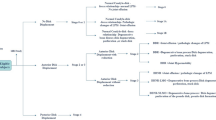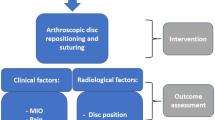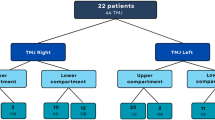Abstract
Design
A four-arm, single-blind, randomised controlled trial (RCT) was conducted in the US. Randomisation was stratified by duration of decreased opening of temporomandibular joint (TMJ) at baseline, as either non-chronic (≤6 months) or chronic (>6 months).
Intervention
Participants with TMJ closed lock were randomised to one of the four initial treatment modalities: medical management, rehabilitation, arthroscopic surgery with postoperative rehabilitation, or anthroplasty with postoperative rehabilitation. Clinical examinations and questionnaires were completed at baseline and at 3, 6, 12, 18, 24 and 60 months.
Outcome measure
The primary outcome measures were the Craniomandibular Index (CMI) and the modified Symptom Severity Index (SSI) for jaw function and TMJ pain respectively. Treating clinicians assessed treatment compliance during the 6-month follow-up. Medication use was also assessed from data collected at follow-up visits.
Results
A total of 106 individuals were randomised to the four treatment modalities. Each participant received the assigned initial treatment modality for at least 3 months, after which some participants in each group needed additional interventions for persistent pain and reduced range of motion. Using an intention-to-treat analysis, no difference was observed between groups at any follow-up for CMI (P≥0.33) or SSI (P≥0.08). Both outcomes showed within-group improvement (P<0.0001) for all groups.
Conclusions
The findings of this study suggest that primary treatment for individuals with TMJ closed lock should consist of medical management or rehabilitation. The use of this approach will avoid unnecessary surgical procedures.
Similar content being viewed by others
Log in or create a free account to read this content
Gain free access to this article, as well as selected content from this journal and more on nature.com
or
References
Fisher L, Dixon D, Jerson J . Intention to treat in clinical trials. In Statistical Issues in Drug Research and Development. Edited by Peace K. New York: Marcel Dekker; 1990.
Hollis S, Campbell F . What is meant by intention to treat analysis? Survey of published randomized controlled trials. Br Med J 1999; 319:670–674.
Author information
Authors and Affiliations
Additional information
Address for correspondence: EL Schiffman, University of Minnesota School of Dentistry, Department of Diagnostic and Biological Sciences, 6-320 Moos Tower, 515 Delaware Street SE, Minneapolis MN 55455, USA. E-mail: schif001@umn.edu
Schiffman EL, Look JO, Hodges JS, et al. Randomized effectiveness study of four therapeutic strategies for TMJ closed lock. J Dent Res 2007; 86:58–63
Rights and permissions
About this article
Cite this article
Tylka, D. Non-surgical care should be the primary treatment for TMJ closed lock. Evid Based Dent 8, 112 (2007). https://doi.org/10.1038/sj.ebd.6400529
Published:
Issue date:
DOI: https://doi.org/10.1038/sj.ebd.6400529



